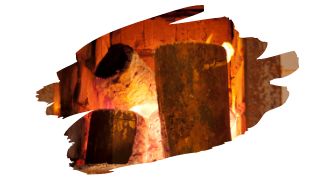Are you looking for a way to add some fun and excitement to your backyard get-together? If so, lighting up that wooden fire pit is a fantastic way to launch a summer BBQ.
However, before you start throwing any old logs on there, you’ll need to be sure you’re using the right kind of wood.
So, in this post, you’ll learn what you need to be on the lookout for, when it comes to choosing firewood. You’ll also discover the three reasons why rotten wood isn’t suitable for an indoor fireplace.
And keep reading to learn how to quickly check if wooden logs are simply too rotten to burn.

This post may contain affiliate links to products that we receive a commission for (at no additional cost to you). Learn more here.
What Is The Best Type Of Firewood For My Fireplace?
The best type of firewood falls under the following criteria;
A). Firewood Needs To Be Dry
Any moisture in firewood will vaporize when you throw that log onto the fire. And if there is a lot of moisture vapor, this will cause high smoke emissions.
Now, freshly cut wood (also called green wood) has a moisture content of 100%. And, if firewood has a moisture content level of 20% or more, then it will emit a lot of smoke.
So, in order to get its moisture content down, you need to season freshly cut firewood for 6-12 months. This is how long it takes for green wood to drop down to a moisture content of below 20%.
Related Post: How To Season Wood (7 Tips)
B). Firewood Should Contain Very Little Sap/Pitch
When there’s a lot of tree sap or tree pitch in firewood, then it can collect in the soot inside a chimney flue. This in turn increases the chances of a chimney fire starting.
C). Firewood Needs To Be Made From Non-Poisonous Trees
Trees filled with poisonous sap are the last thing you want to use to heat your home. All of that sap will vaporize when heated up. Which can then lead to it filling your home with toxic vapor.
Related Post: Can You Safely Burn Camphor Wood In A Fireplace?
And What Kind Of Wood Is The Safest (And Cleanest) To Burn?
Dense hardwoods, such as White Oak and Birch, are ideal for burning in your fireplace. Not only do these non-poisonous lumbers release a lot of heat, they also contain very little sap or pitch.
So, once you’ve seasoned White Oak and Birch wood, you won’t need to worry about them smoking up a storm.
And Can You Burn Rotten Wood?
It will burn. But, even dried rotten hardwood will barely burn hotter than lightweight kindling.
You see, wood rot fungi don’t just live on damp wood…they actively consume it. Which means that rotten wood has been hollowed out, losing a tremendous amount of its density.
This is why we use wood hardeners and fillers to fix rotted wood, and replace the missing wood fiber.
Related Post: What To Do About Rotting Wood In Your Bathroom
But Can Rotten Wood Still Make For Good Firewood?
Well, rotten wood doesn’t make for good firewood for three main reasons; 1) It’s too damp, 2) It’s low density, and 3) It will release a lot of dangerous smoke.
A). Rotten Wood Is Too Damp
The very nature of rotten wood means that this lumber is going to be full of moisture.
And damp wood means that burning it will create a lot of smoke. Although that depends on you even managing to get damp rotten wood to light up in the first place.
Nonetheless, if you allow rotten wood to completely dry out, it will readily burn. Still, this is where you run into the next problem; density.
B). Rotten Wood Is Low-Density
As a general rule of thumb, high density firewood burn hotter and for longer than low density firewood.
This is why White Oak and Birch are so great for firewood. Those two tough hardwoods pack a lot of wood fiber into their straight grain.
Basically, the denser the wood, the more ‘stuff’ there is for fire to consume. This is because it will take more energy to burn that log.
And the more energy it takes to burn something, the hotter the fire.
C). Rotten Wood Emits A Lot Of Smoke
The high levels of moisture in decomposing wood means that it will release excessive amounts of smoke. And that smoke will be filled with lung-burning creosote.
Creosote is the black tar like substance that gets left behind after you burn wood. However, creosote is also present in the smoke released into the air as well.
Creosote is highly carcinogenic and dangerous if you inhale concentrated amounts of it.
However, if you can minimize the amount of smoke emitted from firewood, this isn’t a problem. But, if the firewood you’re using smokes a lot, you’re home could become filled with creosote-filled smog.
How Do You Know If Wood Is Too Rotten To Burn? As long as the wood is dry, it will burn. But if that wood is still punky, and crumbling away easily in your hand, then it is too far gone to bother burning at all.
To Sum Up, Here Are The 3 Key Takeaways From This Post…
- 1). Good firewood is dry, contains very little sap/pitch, and does not come from poisonous trees.
- 2). Rotten wood is often damp and filled with moisture. And this makes it unsuitable for burning in an indoor fireplace.
- 3). Even dried rotten wood doesn’t make for good firewood. And that’s because rotted crumbling wood has very little fiber left in it to burn.
References:
Wood Heating | Utah State University



